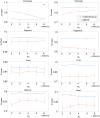Over- and Under-sampling Approach for Extremely Imbalanced and Small Minority Data Problem in Health Record Analysis
- PMID: 32509717
- PMCID: PMC7248318
- DOI: 10.3389/fpubh.2020.00178
Over- and Under-sampling Approach for Extremely Imbalanced and Small Minority Data Problem in Health Record Analysis
Abstract
A considerable amount of health record (HR) data has been stored due to recent advances in the digitalization of medical systems. However, it is not always easy to analyze HR data, particularly when the number of persons with a target disease is too small in comparison with the population. This situation is called the imbalanced data problem. Over-sampling and under-sampling are two approaches for redressing an imbalance between minority and majority examples, which can be combined into ensemble algorithms. However, these approaches do not function when the absolute number of minority examples is small, which is called the extremely imbalanced and small minority (EISM) data problem. The present work proposes a new algorithm called boosting combined with heuristic under-sampling and distribution-based sampling (HUSDOS-Boost) to solve the EISM data problem. To make an artificially balanced dataset from the original imbalanced datasets, HUSDOS-Boost uses both under-sampling and over-sampling to eliminate redundant majority examples based on prior boosting results and to generate artificial minority examples by following the minority class distribution. The performance and characteristics of HUSDOS-Boost were evaluated through application to eight imbalanced datasets. In addition, the algorithm was applied to original clinical HR data to detect patients with stomach cancer. These results showed that HUSDOS-Boost outperformed current imbalanced data handling methods, particularly when the data are EISM. Thus, the proposed HUSDOS-Boost is a useful methodology of HR data analysis.
Keywords: boosting; health record analysis; imbalanced data problem; over- and under-sampling; stomach cancer detection.
Copyright © 2020 Fujiwara, Huang, Hori, Nishioji, Kobayashi, Kamaguchi and Kano.
Figures






References
-
- Kierkegaard P. Electronic health record: wiring Europe's healthcare. Comput Law Secur Rev. (2011) 27:503–15. 10.1016/j.clsr.2011.07.013 - DOI
-
- [Dataset] The US Office of the National Coordinator for Health Information Technology Office-Based Physician Electronic Health Record Adoption (2016). Available online at: dashboard.healthit.gov/quickstats/pages/physician-ehr-adoption-trends.php
-
- Bell B, Thornton K. From promise to reality: achieving the value of an EHR. Healthc Financ Manage. (2011) 65:50–6. - PubMed

